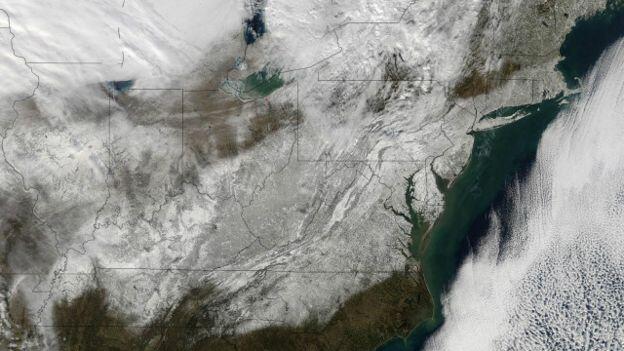New York and Washington, DC have just been smothered by another massive snowstorm, which seems strange when you remember that the world is getting hotter
Snowmageddon has become something of an annual tradition. Barely a year goes by without someone, somewhere, finding themselves on the receiving end of a severe snowstorm. The latest unlucky people, of course, are the inhabitants of New York.
Given that the world is getting steadily warmer as a result of man-made climate change, this strikes many people as pretty weird. Surely we should not be seeing so many extreme snowstorms if the world is getting warmer?
One response, which arrives almost without fail after a heavy snowfall, is the claim that climate change is a myth. But even if you accept the overwhelming scientific consensus that climate change is real, the snowfall still looks puzzling. Maybe the world just hasn’t got warm enough to melt all the snow yet?
The real answer is rather surprising. Extreme snowfall is actually an expected consequence of a warmer world.
This may seem paradoxical, but that is because we often assume that the only requirement for snow is cold weather.
When that warm air met cold, dry air from the Arctic, it formed a winter storm
In reality, heavy snow requires something else: a lot of atmospheric moisture. That moisture generally builds up in pockets of warm air, because the atmosphere can carry 7% more water vapour every time its temperature rises 1C.
Such pockets of warm air are made more abundant by climate change, and they help explain what happened on the US east coast last week.
Partly as a consequence of climate change, the Atlantic Ocean is warmer now than it was even a few decades ago. As a consequence of this ocean warming, the air above the Atlantic is also unusually warm and moist.
When that warm air met cold, dry air from the Arctic, it formed a winter storm, so conditions were just right for a monster snowfall.
The US east coast can expect to be hit with similar extreme winter weather for many years to come, because both ingredients needed to create snowmageddon will continue to occur. The Atlantic Ocean will continue to supply the region with warm, moist air in winter and, just as importantly, the Arctic will keep sending its cold and dry air south.
“It is possible that the Arctic could become ice-free for short periods in about 30 years in deep summer, but in winter the Arctic will still ice over mostly,” says Kevin Trenberth of the National Center for Atmospheric Research in Boulder, Colorado. “So cold continental air will indeed form still.”
But climate change is nothing if not complex. Even if a warmer world helps create the conditions for extreme snowfall events in some regions, this does not necessarily mean more snow will fall overall.
“Extreme snowfall events respond to climate change quite differently from total seasonal snowfall,” says Paul O’Gorman at the Massachusetts Institute of Technology.
The US east coast can expect to be hit with similar extreme winter weather for many years to come
In a 2014 study, O’Gorman used computer models to explore how average and extreme snowfall in the northern hemisphere might change by the end of the century, assuming greenhouse gas emissions remain high.
For regions that are less than 1000m above sea level and that currently experience winter temperatures just below freezing, he found that the chance of an extreme snowfall event will drop by an average of just 8%. But the total amount of snow that falls in these areas each winter may drop by as much as 65%, on average.
“There are regions where total seasonal snowfall is expected to decrease, while the intensity of snowfall extremes doesn’t change much by comparison, or even increases,” says O’Gorman.
The snow season itself may also shorten in future. Both the beginning and end of winter are likely to be warmer across the Northern Hemisphere, so at these times any precipitation will fall as rain rather than snow, according to Trenberth.
In other words, snowy weather may indeed become less common in future, and the season during which snow falls might become shorter, but snowmageddons might still be roughly as common as they are today.
This is bad news for businesses that are built on the white stuff. “Many [US] east coast snow resorts will be out of business owing to the more sporadic nature of the snow storms, unless they can somehow become opportunistic,” says Trenberth.
Source: By Colin Barras, BBC Earth











